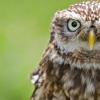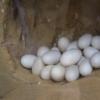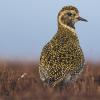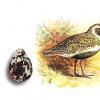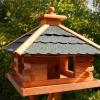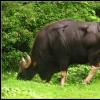About the smallest owl. Owl bird. Owl lifestyle and habitat
Owl family (Strigidae)
Mexican Owl Elf
micrathene whitneyi
Synonym: elf owl, Mexican pygmy owl
The first description of the Mexican elf owl was by James Graham Cooper (1830-1902) in 1861. Doctor and naturalist who participated in several geographical expeditions, James Cooper is known as the author of the first book on birds of California, published in 1870.
"Whitneyi" is a Latin word formed from the surname of Josiah Dwight Whitney (1819-1896), a prominent American geologist and founder of the Harvard School of Mining in 1868. The Elf Owl was first known as "Whitney the Owl". He was also known as - "Texas Elf Owl", "Whitney Elf Owl". In Mexico, this bird is called "enano".
Size: The average length of the female is 16 cm, the male is 15 cm. The average wingspan of the female is 38 cm, the male is 37 cm. Average weight: 44 g. The elf owl is the smallest owl in the world.
Description: The Elf Owl is a tiny night owl native to the barren, arid area of the southern and southwestern United States and Mexico. Body position is vertical. The head is large, there are no ear tufts. The plumage is generally brownish-gray, with white blurred lines on the belly and around the beak. The head and especially the "face" can be much lighter than the rest of the plumage. Forehead, wings and area around the beak with yellow dots. A broken white stripe runs from the shoulder down the back, the same stripe runs along the outer edge of the wings. A white collar, like a collar, runs along the back of the head. The wings are long and protect the short tail. The legs appear to be bare, but they are covered with bristly feathers. The eyes are pale yellow and as if "protruded" to the front by thin white "eyebrows". The beak is gray, the base of the mandible is of various colors. Juveniles are similar to adult birds, but the feathers are brown-gray without spots, the "face" is more gray than in adults.
Voice: Owls-elves have excellent vocal abilities. The voice of the male is high, it sounds like "wow wow wow wow wow". His song can go on almost all night. The song of the male owl is the most sonorous in the spring - in the early evenings and at dawn. In a shorter version of this song, the male attracts females to potential nesting sites. Married couples may sing a duet, but the female's song is quieter and shorter. The male may emit a short "CHU-URU-URU-URU" in flight when he leaves a hollow which he "showed" to his mate. In case of danger, the elf owl emits a signal "chiir". Chicks make the same sound when they are hungry and want to eat.
Hunting and food:
The elf owl's flight pattern is similar to that of a bat, just as agile but less erratic.
Because of their relatively weak legs and claws, elf owls made poor hunters. In fact, all of their prey is insects, although they can occasionally catch a mouse and even a small bird. There have been a few rare cases of elf owlets hunting small lizards and small snakes. Usually the food of an elf owl is made up of grasshoppers, locusts, fly larvae, caterpillars, centipedes, cicadas, as well as scorpions and spiders. If the scorpion is intended for the chick, the parent first removes the stinger and then feeds the scorpion to the chick. Owls-elves hunt at dawn and at sunset, at dusk, and never during the day.
Elf owls get food on the fly, as they are very maneuverable in flight. To catch an insect on the fly, they fly out of the shelter on trees, bushes or cacti. The elf owlet's feathers are not arranged in the same way as those of other owls, so they cannot fly silently, but they do not need to. Flying, elf owls frighten off insects, causing them to fly up, and then peck them. Often, elf owls, in search of insects, fly to the light of campfires or other sources of bright light. Elf owls can also hunt on the ground, pecking out insects from trees or soil.
They carry their prey to a nearby hiding place, where they tear it apart before eating it.
Elf owls are not aggressive birds, they prefer to fly away rather than fight with the enemy.
Nest and breeding: In mid-April, continuously, all night, in the moonlit deserts, male elf owlets begin to sing their song, attracting females. it was not occupied by other birds.
The habitats of elf owls are closely related to the giant saguaro cacti. Owls nest in saguar hollows, located at a height of two or more meters from the ground. Sometimes together with other small owls and woodpeckers, which gouge out these nests. Such a neighborhood is forced - the owl itself cannot hollow out a nest because of a weak beak. Some species of woodpeckers, precisely because of these neighbors, make more than one hollow for themselves. However, if the owl finds a nest in some other tree, it can also live in it. Elf owl nests have been found in mesquite trees, oaks, plane trees, walnuts, and pines. Sometimes birds settle in hollows that woodpeckers have hollowed out in telephone poles.
The entrance to the nest is usually located 3 to 10 meters above the ground. In the first days of April-May, female elf owls lay up to 5 white eggs (on average 3) with an interval of 1 to 3 days. Incubation begins after the second egg is laid and lasts two to three weeks. Unlike other owls, the female elf owl sometimes hunts at dusk during the incubation period, leaving the care of the eggs in her absence to the partner.
The chicks are fed by the female as she processes the food that the male brings her. During the peak of the hunt, the male can bring food to the female once a minute.
Chicks fledge at 28-33 days. Since elf owls have fairly well-protected nests, they have the highest percentage of chick survival among all North American owls (out of all the eggs laid, 70% of hatched chicks survive to fledge). These high rates are achieved due to the fact that it is difficult for predators to get to the nests of elf owls, especially those that live in cacti.
Mortality: In captivity, elf owls lived for more than 5 years. In nature, these birds have few enemies and, as previously mentioned, it is difficult for predators to get to the nests of elf owlets.
 Habitat: Owl-elf lives in desert, arid areas, coastal wooded areas and adjacent plateaus from 600 to 2200 meters above sea level. They live in gorges, canyons, plateaus, and on mountain slopes. Their habitat is the south and southwest of the United States (Arizona, California, New Mexico) and Mexico (Baja California)
Habitat: Owl-elf lives in desert, arid areas, coastal wooded areas and adjacent plateaus from 600 to 2200 meters above sea level. They live in gorges, canyons, plateaus, and on mountain slopes. Their habitat is the south and southwest of the United States (Arizona, California, New Mexico) and Mexico (Baja California)
Subspecies: There are 4 recognized subspecies of this owl.
Micrathene whitneyi whitneyi - southwestern United States, northern Mexico
Micrathene whitneyi idonea - southeastern California, southwestern New Mexico and Sonora
Micrathene whitneyi sanfordi - Southern California
Micrathene whitneyi graysoni - Socorro Island
Since ancient times, there have been many legends around this small bird. Our ancestors believed that whoever sees her will experience difficulties in life. They say, like a black cat that crossed the road, this feathered one is able to invite trouble. But in fact, an owl is just a small owl with a very unusual appearance. If you do not understand in detail, then many people will not find any differences between an owl and an ordinary owl.
general characteristics
The owl is a small bird. The length of her body does not exceed thirty centimeters, and her weight does not reach 200 g. If we compare an owl with an ordinary owl, then it will resemble a chick of the latter, because the body length of an owl reaches 67-70 cm, and its weight is up to 700 g. signs you can see that the head of an owl has a more rounded shape, while in an owl it is flattened. On his head you will not find feathers that resemble ears in shape. Otherwise, the owl is no different from the owl.
Also, this bird is characterized by the external features of a gloomy person, since the feathers above the eyes are more like eyebrows. Owls are farsighted, they can notice prey at a great distance, but not see what is happening a few centimeters from them. This bird has a short tail, which helps it to create the effect of a large wingspan.
The size of the owl does not prevent him from being a skilled hunter. Depending on the species, they feed on different prey, but mainly rodents and some varieties of beetles are included in their diet. These birds are very selective and can catch prey according to their own preferences. Sometimes they hunt in pairs, usually in this way owls catch larger prey, such as rats.
The habitat of the described birds is very extensive, they can be found in any corner of the planet, except for Antarctica. According to external data, owls of different species are very similar, but there are also interesting features.
Owl
The Rough-legged Owl is a small owl with a rounded head. In size, this species is slightly larger than a dove. The color of the bird is brown, with white spots all over the body. The head is large, with asymmetrical facial discs.
The Rough-legged Owl is distinguished by a rather small eye size and a weak beak. Its legs are covered with dense plumage, which led to the name "furry-legged". The bird's beak is yellow.
The nesting of the boreal owls lasts almost a month. The clutch is more than six eggs. Hairy owls nest mainly in hollows. Their main diet is field mice and beetles.
The owl is a nocturnal bird, but in some areas it can also lead a daytime lifestyle. Upland owls prefer to live in coniferous forests. Such birds live in Russia, Northern Mongolia, Western China and the northern regions of the United States.
Brown Owl
The little owl is a brown-colored bird with small white spots. It has a small head and a short tail. The size of this bird is slightly larger than that of the upland. He prefers to settle in open areas, in the mountains or on the plain. How an owl screams, you can find out when you are close to its nest. The singing is more like a whistle.

Owls are very consistent birds in terms of mate choice. Regardless of the breeding season, they always stick together. They try to create nests in minks, sometimes they dig them themselves. And sometimes they find shelter in old abandoned buildings.
The clutch of the little owl is more than 7 eggs. Birds usually hunt during the day. The main diet consists of small birds and rodents. The described species lives in North Africa, in Asia, as well as in Central and Southern Europe.
Elf Owl
It is a tiny cinnamon-colored owl with gray and white lines. Her eyes are large, yellow, her beak is gray. Legs without plumage, but covered with bristles. These amazing birds fly like bats, only more coordinated. They are not aggressive. Never get into a fight. They prefer to build nests in hollows. There are no more than five eggs in the clutch of this bird.

The elf owl absolutely does not know how to hunt because of the weak beak and non-grasping paws. Their diet consists of various insects. Birds live in the USA and Mexico, where they settle in the trunks of saguaro cacti.
Sparrow Owl
The sparrow owl is the northernmost representative of the owls. It has a brownish-white color and a yellow beak. The legs are densely feathered, down to the claws, which are dark in color.
Sparrow owls are excellent hunters, they are distinguished by a strong beak and tenacious paws. This bird prefers to settle in the hollows of coniferous trees. The clutch of eggs is usually no more than five eggs.

The named bird hunts regardless of the time of day. And the main diet is rodents and small birds. These are very thrifty birds - before the onset of winter, the pygmy owl collects prey in a hollow and carefully stores it until the onset of cold weather. Sparrow owls live in Russia, Europe and North Asia.
rabbit owl
These owls are the most unique birds of all of the above. They lead a very active daytime lifestyle. They have a bright sand color with small white speckles. The burrowing owl is a ground hunter and has long legs and a neck that they like to stretch out. These birds live in colonies and all together are ready to attack the enemy who has encroached on their nest.
Chicks of this species of owls are capable of making very interesting sounds. When danger comes, they begin to crackle, imitating a rattlesnake.
These birds are very fond of settling in burrows dug by some mammals. The burrowing owls actively protect their clutches, the female tries to stay as far as possible from the entrance to the hole, and the male makes distracting maneuvers, trying to confuse the predators. Usually in the laying of rabbit owls there are up to five eggs. The most interesting thing is that while the female incubates the eggs, the male lives in another hole. The habitat of these birds is America.

What is the difference between an owl and an owl
In the article, we have already listed the characteristics that the owl possesses. The eagle owl, like the owl, belongs to the owl family. It is very easy to distinguish between these two birds:
- The owl leads a daytime lifestyle. This is the main distinguishing feature of the bird, since the dark time of the day is considered the main and constant period of wakefulness of the eagle owl.
- The owl is much larger than the owl. Its length reaches 80 cm, and the weight can be 4 kg. It is difficult not to notice, while the owl can easily hide.
- The diet of owls is much more extensive than that of an owl. Due to strong paws and a powerful beak, the eagle owl can attack large mammals.
- The eagle owl has large feather ears, which are not characteristic of many varieties of owls.
- The eyes of an owl may have a red iris, which is absolutely not typical of yellow-eyed owls.
Appearance
Tiny owl, body length about 12-14 cm, weight - about 44g. Body position is vertical. The owl has a relatively large head, no ears. Weak beak and weak paws. Wings rounded, long; The wingspan is on average 37-38 cm. In a short tail (length 4.5-5.3 cm), unlike other owls, there are 10 tail feathers. The legs are covered with bristly feathers. Greyish-brown with buffy or whitish markings (some primary and secondary feathers may have white tips, which cause white dots on the back); on the belly white with reddish-brown stains; Collar white or brown. There are 3-5 light red or brown horizontal stripes on the tail. A broken white line runs from the shoulder along the back, the same goes along the edge of the wing. The head and especially the face can be much lighter than the rest of the plumage. The color is more brown on the back and more orange on the head, chest and belly. There are yellow dots around the beak, along the edges of the wings and on the forehead. White "eyebrows" above the eyes. The iris is lemon yellow, the beak and claws are pale brown or gray, the base of the beak can be of different colors. In young owls, the color is not so variegated, there are no spots and the face is more gray.
Lifestyle
Elf owls have weak legs and claws, which makes hunting very difficult. They usually only feed on insects: grasshoppers, locusts, moths, fly larvae, caterpillars, centipedes and cicadas, as well as scorpions and spiders. If the scorpion is intended for the chick, the parent first removes the stinger and then feeds the scorpion to the chick. Owls-elves hunt at dawn and at sunset, at dusk, and never during the day. Their flight is a bit like the flight of bats and in flight they are very maneuverable, so they prefer to hunt on the fly. Owl feathers are arranged differently from other owls, and do not allow them to fly silently, but they do not need to. They scare insects into flight and then peck at them. From time to time, owls hunt on the ground, pecking out insects from trees or the ground. Occasionally, cactus owls will fly up to campfires or other bright lights in search of flying insects. Before eating the prey, the owls carry it to the shelter, where they tear it to pieces, and then eat it. The pellets are small, dry and shapeless. They contain mostly insect body parts and often fall apart shortly after the bird throws them off. Elf Owls are not very aggressive and prefer to fly away from danger rather than fight. In captivity, elf owls lived up to 5 years.
Elf Owl Chicks
reproduction
In mid-April, male elf owls begin to sing at night, attracting potential partners to the nesting site. When two owls pair up, the female immediately roosts in the selected nest to prevent it from being occupied by other birds. The entrance to the nest is located at a height of 2 to 10 meters. In April-May, owls lay from 2 to 5 eggs (most often 3) with an interval of 1-3 days. Hatching begins with the second egg and lasts 21-24 days. Unlike other types of owls, the female elf owl sometimes hunts at night during the incubation period, at which time her partner takes care of the eggs. The female feeds the chicks, but the male brings her food. In the midst of the hunt, the male can bring food very often, about once a minute. Plumage in chicks appears on the 28-33 day. It is difficult for raptors to get to the nests of elf owls, therefore they have the highest breeding percentage of all North American owls. Of all the eggs laid, 70% of the chicks survive to fledge. This is due to the fact that it is difficult for predators to get to nests, especially those that are in cacti.
Spreading
The elf owl lives in desert, arid areas, coastal wooded areas and adjacent plateaus from 600 to 2,200 meters above sea level. They live in gorges, canyons, plateaus, and on mountain slopes. Their habitat is the southwestern United States (Baja California, Arizona) and Mexico. Their habitat is closely related to the giant saguaro cacti. In the hollows of these cacti, located at a height of 2 or more meters from the ground, owls nest. Sometimes together with other small owls and woodpeckers, which gouge out these nests. Such a neighborhood is forced - the owl itself cannot hollow out the nest because of the weak beak. However, if the owl finds a nest in some other tree, he can also live in it. Elf owl nests have been found in mesquite trees,
There are many signs associated with the owl bird. Most of them are not the most favorable. Our ancestors believed that this bird warns of imminent danger. If you see it, a real nuisance is possible, both in the material plane (for example, to fall or cripple) and in the intangible (someone does evil to you).
Features and habitat of the owl
Owl bird - a small owl, with an unusual appearance. Many people do not even know how they differ from ordinary ones. The size of the owl is small. The length of its body reaches only 30 cm, and its weight is about 200 g.
Ordinary owls are much larger: length - up to 65 cm and weight - up to 700 g. Owl head is rounded. In owls, it is flattened. The plumage of owls is brown, with white, small spots.
In owls, longitudinal and transverse lines are easily distinguishable on feathers. In addition, owls do not have feathers that resemble ears. Otherwise, they are no different from their relatives from the family.

Huge eyes are located on the large head of the owl, they are fixed in the eye sockets. Therefore, in order for the bird to look in any direction, it is necessary to turn its head.
There is an opinion that owls can turn it back. This is a mistake, the feathered head turns 135 degrees in any direction, which makes it possible for the bird to look over its shoulder.
Owls have farsightedness. At a distance of a few centimeters, they see nothing. However, at a great distance and in the dark, vision from is simply excellent. Filamentous feathers located on the paws and beak help them to distinguish between prey, they act as a "sensor".
Owl bird looks very seriously. This emphasizes the corolla and the protrusions above the eyes, like eyebrows. Because of its appearance, the feathered one is comparable to a person who is characterized by gloominess. . Owl bird makes whistling sounds, unusual for owls and its name displays the word "whistle".

A dense body, of small length, ends in a shortened tail, which increases the visual size of the wings. The legs of the owl are covered with feathers, the length of which varies in different species.
The range of owls is quite extensive. They can be found on almost all continents, with the exception of Antarctica. In appearance, owls from different places are hardly distinguishable.
The nature and lifestyle of the owl
Owls are sedentary birds. The exception is the genus Athene, which lives in the highlands and can descend to the flat terrain. The choice of housing for representatives of these birds is quite different.
For example, the most common Athene owls, in warm areas, prefer open spaces such as steppes and semi-deserts. Northern species prefer forests or settle near human dwellings. Their houses are quite varied. Nests can be found in burrows, wells, wood piles, and in the attics of buildings.

In the photo, an owl is an elf in the hollow of a huge cactus
The elf owl lives in the southwest of the North American continent. With a weak beak, they are not able to hollow out the nest themselves, therefore they settle in the nests of other birds or tree hollows. One of these places is the hollow of a huge saguaro cactus. Rough-legged Owl lives in the coniferous forests of the foothills.
pygmy owl, mainly lives in hollows of trees that are in a mixed forest. The owl is a night bird. However, there are exceptions. For example, the pygmy owl is active in the morning and at sunset, while the elf owl chooses nocturnal activities. For the northern inhabitants, the time of hunting becomes a long, polar day.
How the owl bird screams, many people know, but it is not easy to notice it. This is facilitated by stealth and camouflage coloration, hiding the owl against the background of trees. It is interesting that listening to the owl bird screaming at night portends rainy weather.
Owl food
The zygodactyl structure of the paws helps the owls to hunt and easily grab prey. That is, two fingers of the bird are directed forward, and two - back. When perching, the bird can turn one finger towards the front.
Owls have no teeth, so they do not chew their prey. They tear it into small pieces or swallow it whole. Parts that cannot be recycled, such as feathers, bone, or fur, are regurgitated later.
The style of hunting and the diet of different species of owls differ significantly. The food of the little owl is: voles, hamsters, and even bats. He does not disdain insects and earthworms.

The owl patiently guards the victim and attacks when it stops moving. Both heaven and earth are suitable for hunting. House owls constantly stock up.
The pygmy owl prefers small birds and rodents. The victim is not swallowed whole. Prey is meticulously plucked, the best pieces are selected from it. In autumn, food in reserve is hidden in a hollow.
The long-legged owl flies above the ground, looking for prey. For an ambush, a small height is selected. The object of hunting is birds and rodents. Food is swallowed whole.
Owl-elf - insectivorous. Its diet includes grasshoppers and locusts, fly larvae, centipedes, caterpillars and cicadas. Often scorpions become prey. The feast takes place exclusively at home.

pygmy owl
Reproduction and lifespan of an owl
In the spring, the owls begin the mating season. At this time, male owl birds call females with their voice. In mid-spring, the female lays about five eggs, which have a white, granular shell.
While she is incubating her eggs, the male has to feed her. The male pygmy owl begins to feed the expectant mother even before she starts laying eggs. And the future father of the elf owls gives the opportunity to the female on her own and replacing her on the masonry.
Chicks appear in a month. They are blind and covered in down. Immediately after birth, the female Pygmy Owl cleans the house and frees it from debris. Children grow quickly and reach the size of their parents in a month. They become completely independent by August.

The survival rate of owls is very high, because their dwelling is practically inaccessible to predators. The average life expectancy of owls is 15 years.
The mystery of owls causes a certain fear in people. Many beliefs and signs are associated with these birds. But if you get to know them better, it is impossible not to notice their intelligence and attractiveness.



